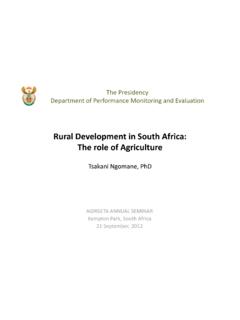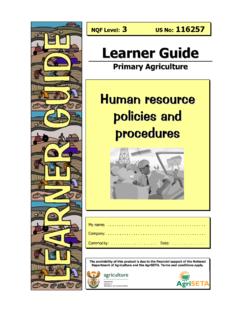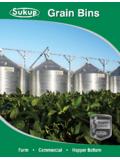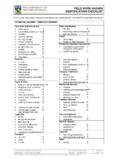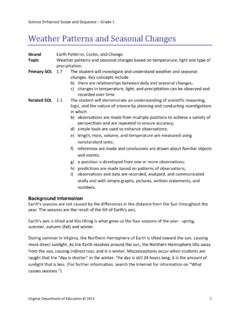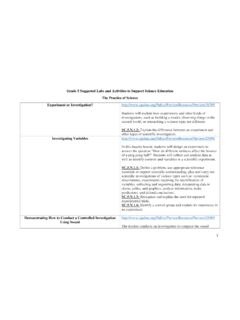Transcription of Collect Agricultural Data - AgriSeta
1 AAsssseessssmmeenntt GGuuiiddee PPrriimmaarryy AAggrriiccuullttuurree ll CCoolllleecctt AAggrriiccuullttuurraall DDaattaa NQF Level:2 US No: 116080 The availability of this product is due to the financial support of the National Department of Agriculture and the AgriSeta . Assessor: .. Workplace / Company: .. Commodity: .. Date: ..Monitor, Collect and collate Agricultural data Primary Agriculture NQF Level 2 Unit Standard No: 116080 22 Version: 01 Version Date: July 2006 BBeeffoorree wwee his assessment guide contains all necessary activities and instructions that will enable the assessor and learner to gather evidence of the learner s competence as required by the unit standard.
2 This guide was designed to be used by a trained and accredited assessor whom is registered to assess this specific unit standard as per the requirements of the AgriSeta ETQA. Prior to the delivery of the program the facilitator and assessor must familiarise themselves with content of this guide, as well as the content of the relevant Learner Workbook. The assessor, facilitator and learner must plan the assessment process together, in order to offer the learner the maximum support, and the opportunity to reflect competence. The policies and procedures that are required during the application of this assessment are available on the website of the AgriSeta and should be strictly adhered to. The assessor must familiarise him/herself with this document before proceeding.
3 This guide provides step-by-step instructions for the assessment process of: This unit standard is one of the building blocks in the qualification listed below. Please mark the qualification you are currently assessing, because that will be determined by the context of application: Title ID Number NQF Level Credits Mark National Certificate in Plant Production 48975 2 120 U National Certificate in Animal Production 48976 2 120 U National Certificate in Mixed Farming Systems 48977 2 120 U Please mark the learning program you are enrolled in: TT Title: Collect Agricultural data US No:116080 NQF Level: 2 Credits: 2 Are you enrolled in a: Y N Learnership? U U Skills Program? U U Short Course? U U PPlleeaassee NNoottee:: This Unit Standard 116080 Assessment Guide must be read in conjunction with the generic Assessor Guide as prescribed and published by the AgriSeta .
4 NNoottee ttoo AAsssseessssoorr:: If you are assessing this module as part of a full qualification or learnership, please ensure that you have familiarized yourself with the content of the qualification. Monitor, Collect and collate Agricultural data Primary Agriculture NQF Level 2 Unit Standard No: 116080 33 Version: 01 Version Date: July 2006 1. List the data that you think will be important for on farm to Collect (mention at least 8 kinds)? Model Answer(s): Weather, financial, pest and disease control, stock control, repairs and maintenance records, agro-chemical applications, fertilisation actions, soil preparation actions, planting records, manipulation records, soil surveys, wage records, quality and quantity yields, data required to do apply spraying (collecting data to calibrate spraying equipment).
5 2. How many different methods of data recording can you think of? Model Answer(s): Interpreting a gauge. Measuring. Observing. Collecting samples. Counting. Scouting. Monitoring by trapping devices: sticky traps, pheromone traps, trap-crops. Instructions to learner: Hold a class discussion and make lists of the following: 11 SSOO 11 AACC 11--22 Learner Guide: Page 10 Facilitator Guide: Page 12 MMyy NNootteess .. Monitor, Collect and collate Agricultural data Primary Agriculture NQF Level 2 Unit Standard No: 116080 44 Version: 01 Version Date: July 2006 You have to explain to a new worker on the farm about sampling. (Make keynotes for yourself in order to remember what you learn.)
6 1. Why is sampling necessary on a farm, for example the sampling of pest data on a specific crop, or parasites on live stock? Model Answer(s): Sampling gives an indication of the types of pests/parasites present. One can identify the pests/parasites This data can provide a measure of infestation level to the crop. This data provide the farm worker with an opportunity to take a decision to spray or record the data . 2. Explain ddifferent methods of data collecting you can do to Collect weather data over a period of 6 months? Model Answer(s): Can be measured manually and recorded daily on a recording sheet. Weather data can be obtained by searching on the web, or by contacting some provider of weather data ( Hartebeespoort Weather station) (electronically).
7 3. Explain what kind of sampling you would carry out to take soil samples to plant a crop maize or cotton, and mention the steps? Model Answer(s): Choose the field, and decide on the number of samples. Choose the random sites Select the necessary equipment to be used. Take the samples with a spade, auger or tool, and mix appropriate samples, Mark the samples, depth and record the locality, date etc. Handle samples as required (keep cool). Deliver samples to the laboratory. Instructions to learner: Hold a class discussion and make lists of the following: 22 SSOO 11 AACC 11--33 Learner Guide: Page 16 Facilitator Guide: Page 12 Monitor, Collect and collate Agricultural data Primary Agriculture NQF Level 2 Unit Standard No: 116080 55 Version: 01 Version Date: July 2006 4.
8 Explain the kind of sampling when recording rain measurements from a gauge over a period of time (1) and what procedure to follow when performing stock taking of chemicals in the store (2). Model Answer(s): (1) Record measurements in mm. daily. Empty the rain gauge after each measurement and recording. Combine a months (or week) of data and calculate and average if necessary. (2) Record names of chemicals. Record quantities of chemicals. Examine the expiring data . Record and sort chemicals to be considered as waste. Compare and combine data on chemicals which can still be used. 5. Explain to him / her, what procedure to follow when collecting a sample of your crop for quality control, cotton lint sample for quality analyses.
9 Model Answer(s): Random sampling of the yield of a large surface area (approx. 1 ha +) is important. Take a number of samples at random from the same fields harvest (seed cotton, fruit etc). Harvesting should have taken place according to best management practices. Mark these samples individually, collate the samples, repack and label as necessary. Weigh or grade these samples as required by the type of crop. Record all data for each field and harvest. MMyy NNootteess .. Monitor, Collect and collate Agricultural data Primary Agriculture NQF Level 2 Unit Standard No: 116080 66 Version: 01 Version Date: July 2006 1. Explain what collate means and identify the relevant data needed to fit the objective.
10 Model Answer(s): Leaf, Soil Fruit sampling, pest numbers. Depending on the objective of the sampling of data , the type of data gathered will differ. For pest control on field crops, eg. For maize, collecting scouting data will include for example, leafhoppers, American bollworm, leaf-worms, maize stalk borer, spotted black maize beetles, false-wire worms etc. For the purpose of controlling insects that would have an effect on maize cobs, one would sort, record and combine the larval data . For the purpose of protecting maize stand (population density) the farmer would compare and combine beetle larvae that would affect the number of maize seedlings at an early planting stage. Collate thus means to compare, combine and record data .
